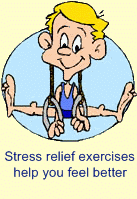Stress Relief Exercises Gently
Reduce Stress Naturally

Stress relief exercises are useful for both long term stress prevention and immediate tension relief.
The key is moderation.
A sedentary life does not support long term optimum health. But exercise which is too much, too frequent, or too vigorous for your body and current fitness level, can simply produce more stress.
A friend of mine once asked her yoga teacher which yoga postures would make her feel peaceful and healthy. Her teacher replied “the key is not so much which postures you do but how you do them, how much effort do you use…..not too much……not too little.”
I use my breath as a guide. If my breathing is rough and heavy through the mouth I am using too much effort. Breathing gently and softly through the nose, even while exercising gives much more stress relief.
Beneficial Results of Moderate
Stress Relief Exercise Include:
- normalize blood sugar
- normalize blood pressure
- reduce the risk of cardiovascular disease
- stimulate the release of endorphins, which enhance our feeling of happiness and well being
- lower our levels of stress hormones like adrenaline and cortisol, so we can feel more relaxed and safe.
- keep our bodies strong and flexible so living can be a more joyful experience.
Stress relief exercises are like shaking out the cobwebs. We can feel relaxed, enlivened and refreshed afterward. You don’t need to strain after the Olympic gold medal if that’s not your style. Find your own pace.
But I’ll tell you from personal experience, thinking about exercise never gave me the benefits of actually doing the exercise. So don’t procrastinate, just get moving.
Try these tips to help you maintain an exercise routine...
Infuse Fun Into Your
Stress Relief Activities
Some ideas to try include:
- Find friends to keep you company!
- Get a dog and visit the park together.
- Borrow your neighbor’s dog if you don’t have one of your own.
- Exercise to your favorite music. Some of the old classics like Louis Armstrong make superb exercise and dance music. Or, if you are more classically oriented try some Tchaikovsky ballet music. The Beatles or the BeeGees can also help.
Vary Your Exercise
Try New Activities
For stress relief exercises to work effectively, it is a good idea to vary both the activities you do and the pace with which you move. Sometimes faster, sometimes slower, there is no single right way to exercise.
Varying your stress relief exercise routine has several benefits:
- This will condition your body to adapt to a broader range of circumstances.
- Also, with cross training, (doing different activities on different days) there is less chance of repetitive injury.
- There is less boredom, and so you are more likely to be willing to exercise.
Vary your exercise with the seasons and the weather.
Try bicycling, hiking, swimming in the warm weather or ice skating and skiing in the winter.
Exercising outdoors in a natural setting and fresh air is wonderful. Try yoga, tai chi, palates or calisthenics when your exercise needs to be indoors.
Use All 4 Types of
Stress Reduction Exercise
Experts say a well rounded balanced exercise program usually includes:
- aerobics to improve cardiovascular health and endurance,
- resistance training to increase muscle mass and strength and
- stretching to promote joint mobility and flexibility.
- mind body integration training
to increase balance, reaction time and coordination between mind and
body. Unfortunately this type of exercise if often overlooked.
Examples of mind body integration training are learning to juggle, or learning to integrate a wide range of different types of movements and speeds. A Nia class is a perfect example of this kind of activity.
To Get Best Results
Exercise Regularly
Relieving stress by exercise is especially effective when it is done systematically over time. Almost every day is best. Exercise is one of the essential foundations of good health and happiness.
However, avoid an all or nothing, or perfectionist mentality. Even a little stress relief exercise, like a 30 minute walk can make a huge difference.
Involve other people in your stress relief exercise activities. This adds a dimension of social enjoyment as well as reinforced commitment. You might:

- Exercise with a friend or commitment partner.
- Join a team. You might try a new sport you have never played.
- Take a class. Dance classes can be fun....then go dancing! Try different styles: folk, ballroom, disco, rock and roll, and Nia are all possibilities.
- Join a gym or hire a personal trainer.
Many people find exercising at the same time each day, usually in the morning, helps them to stay “on track”.
But most of all, find a few activities which you really enjoy. It will make exercising much more likely to happen.
Goals Are Useful to
Keep Motivation High
Many people find that setting exercise goals helps motivate them to exercise regularly. Your goal might be to climb a local mountain trail, or to participate in a local race or on a sports team.
For best results relieving stress by exercise, try to make your goal realistic to your age and body type. For example, if your body build is small and frail, playing professional football might not be your most appropriate goal. If your body is built more like a tank, deciding to become a ballerina might not be wise.
It is best to set realistic goals for the body you actually have rather than the body you wish you had, or used to have.
Exercise Realistically and Responsibly
While relieving stress by exercise is very effective, if done improperly or too aggressively it can also increase stress and injury so...
- Exercise in ways which are appropriate for your age and body type. People who are younger or have a solid, sturdy build may require more strenuous exercise for optimum health. People who are older, or who have a more delicate or frail build may thrive on slower, gentler exercise routines.
- Be patient. Regardless of your age or body type, if you are out of shape, start slowly and build up gradually. Be content to progress at a moderate, safe pace. If you have prior injuries, or a medical condition, consult with you doctor, health care practitioner or a good physical therapist.
- For greatest exercise benefits many experts recommend a few minutes of gentle warm up activity followed by more rigorous challenging exercise, followed by a slower, gentler period of cool down activity. The warm up period helps to avoid strain and injury. The cool down period helps to minimize muscle soreness afterward.
I suggest being less concerned about how you look, or how you “measure up” compared to someone else, and more concerned with how your body feels. I often have to start a new program of stress relief exercises much more slowly and gently then is usually recommended to an “average” beginner. But “exercising” that patience helps me to avoid injury and to feel better.
Whether you are a rank beginner or a professional athlete, if you are looking for more specific guidelines on tailoring a stress relief exercise program to your body type and fitness level, I suggest “Body, Mind and Sport the Mind-Body Guide to Lifelong Fitness and Your Personal Best” by John Douillard.
Share YOUR Favorite
Stress Relief Exercises
For me, walking has always been a great source of stress relief. Walking is especially soothing and grounding if I can do it outside in a beautiful setting. And yoga is really gentle and relaxing too.
But lately, I have also been enjoying my Total Gym workout. Doing systematic resistance exercise in my own home is convenient and helps me work off some of my excess muscle tension. The equipment folds up for easy storage and the resistance levels can be adjusted for each person and exercise. I find it works my muscles while being gentle on my joints. Best of all, it is helping me to maintain a healthy level of muscle mass as my body ages.
Share your story, what you do and what results you have noticed, so other website visitors can get some new ideas about what works well for stress relief.
What Other Visitors Have Said
Click below to see contributions from other visitors to this page...
Excercise Activities to Release Stress and Anger
Go for a walk, yourself or with someone.
Take long nice bike ride sometimes works!!
Amy's Stress Relief Exercise Story
I have an anger problem but I manage to control my anger by talking and walking.
Thanks for sharing your story Amy.
Anger can certainly be stressful. …
Explore other Stress Prevention Healthy Lifestyle Choices which can help build your strength, energy and resilience, or...
Return to Gentle Stress Relief home page to explore many additional stress relief tips.
Looking for more resources?
Yoga is a traditional type of stress relief exercises which works on many levels, from physical to mental.
Click here to learn more about Yoga and stress relief.
Sources:
exercise. (2008). Encyclopaedia Britannica. Encyclopaedia Britannica 2007 Deluxe Edition. Chicago: Encyclopaedia Britannica.
newsinhealth.nih.gov, January 2007. “Stressed Out?” http://newsinhealth.nih.gov/pdf/NIHNiH%20January07.pdf
Douillard, John. 1994. Body, Mind and Sport The Mind-Body Guide to Lifelong Fitness and Your Personal Best . New York: Crown Trade Paperbacks
Van Voorhees, Benjamin W., MD, MPH, 7/27/2007. “Stress vs. anxiety”http://www.nlm.nih.gov/medlineplus/ency/article/002140.htm
